Foreword / YouTube Video Review
I purchased these speakers myself with funds from Patreon and will be giving them away to a Patron.
Also note the bottom section of this review will have some additional stuff that you might be interested in with respect to the DIY aspect of this speaker and verification of the completed speaker’s results.
The review on this website is a brief overview and summary of the objective performance of this speaker. It is not intended to be a deep dive. Moreso, this is information for those who prefer “just the facts” and prefer to have the data without the filler. The video below has more discussion.
< coming soon >
Information and Photos
Specs from the manufacturer can be found here.
- True full-range point source frequency response from 80 to 20,000 Hz
- Angled enclosure puts drivers on-axis for extremely predictable response
- Dayton Audio’s famous PS95-8 delivers excellent detail and articulation with low distortion
- Easy to assemble enclosure and filter design makes this kit perfect for beginners
- Compact footprint and bottom ported design takes up minimal desk space
- Customize the precision cut CNC enclosure to fit any décor
- This kit includes everything required for assembly; enclosure, drivers, crossover components, binding posts, screws, and wire
The current price is approximately $119 USD for the pair.
Below you can see the kit pieces laid out, getting ready to be built.
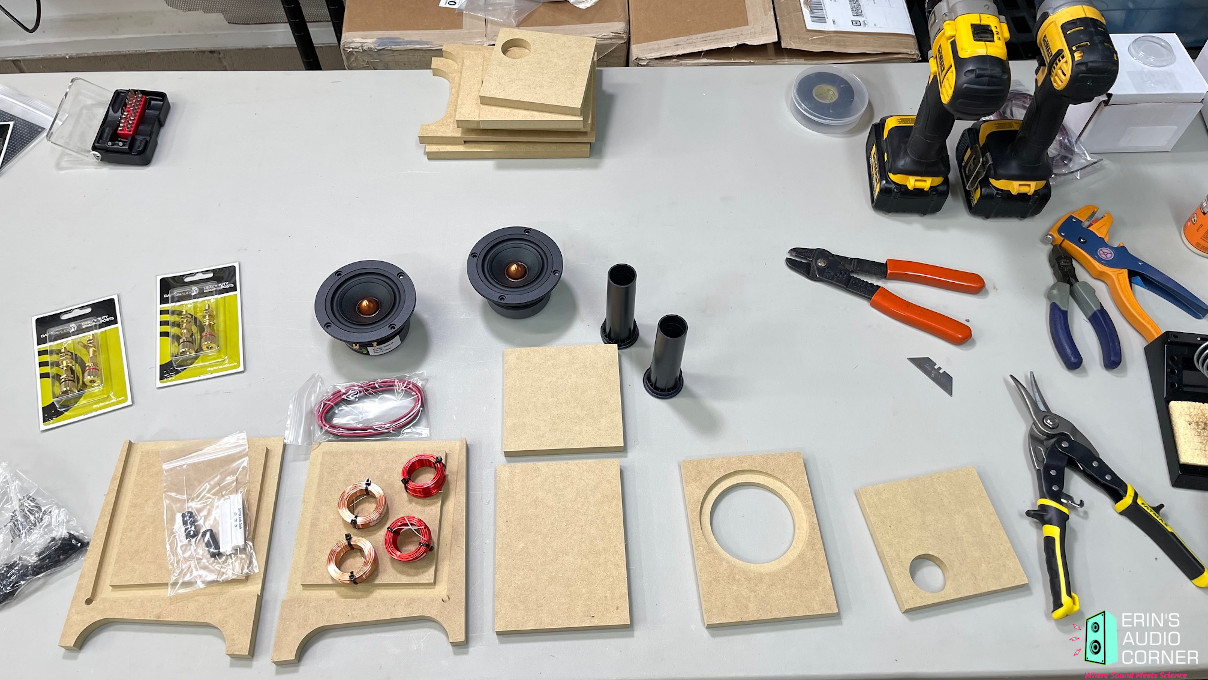
CTA-2034 (SPINORAMA) and Accompanying Data
All data collected using Klippel’s Near-Field Scanner. The Near-Field-Scanner 3D (NFS) offers a fully automated acoustic measurement of direct sound radiated from the source under test. The radiated sound is determined in any desired distance and angle in the 3D space outside the scanning surface. Directivity, sound power, SPL response and many more key figures are obtained for any kind of loudspeaker and audio system in near field applications (e.g. studio monitors, mobile devices) as well as far field applications (e.g. professional audio systems). Utilizing a minimum of measurement points, a comprehensive data set is generated containing the loudspeaker’s high resolution, free field sound radiation in the near and far field. For a detailed explanation of how the NFS works and the science behind it, please watch the below discussion with designer Christian Bellmann:
The reference plane in this test is at the full-range driver. However, note that the enclosure has a bit of a tilt to it; about 3-5° or so (judging by eye). Despite this, the measurement axis is on-axis with the driver. In other words, if you drew a straight line from the angle of the driver, the measurement axis follows that.
Measurements are provided in a format in accordance with the Standard Method of Measurement for In-Home Loudspeakers (ANSI/CTA-2034-A R-2020). For more information, please see this link.
CTA-2034 / SPINORAMA:
The On-axis Frequency Response (0°) is the universal starting point and in many situations it is a fair representation of the first sound to arrive at a listener’s ears.
The Listening Window is a spatial average of the nine amplitude responses in the ±10º vertical and ±30º horizontal angular range. This encompasses those listeners who sit within a typical home theater audience, as well as those who disregard the normal rules when listening alone.
The Early Reflections curve is an estimate of all single-bounce, first-reflections, in a typical listening room.
Sound Power represents all of the sounds arriving at the listening position after any number of reflections from any direction. It is the weighted rms average of all 70 measurements, with individual measurements weighted according to the portion of the spherical surface that they represent.
Sound Power Directivity Index (SPDI): In this standard the SPDI is defined as the difference between the listening window curve and the sound power curve.
Early Reflections Directivity Index (EPDI): is defined as the difference between the listening window curve and the early reflections curve. In small rooms, early reflections figure prominently in what is measured and heard in the room so this curve may provide insights into potential sound quality.
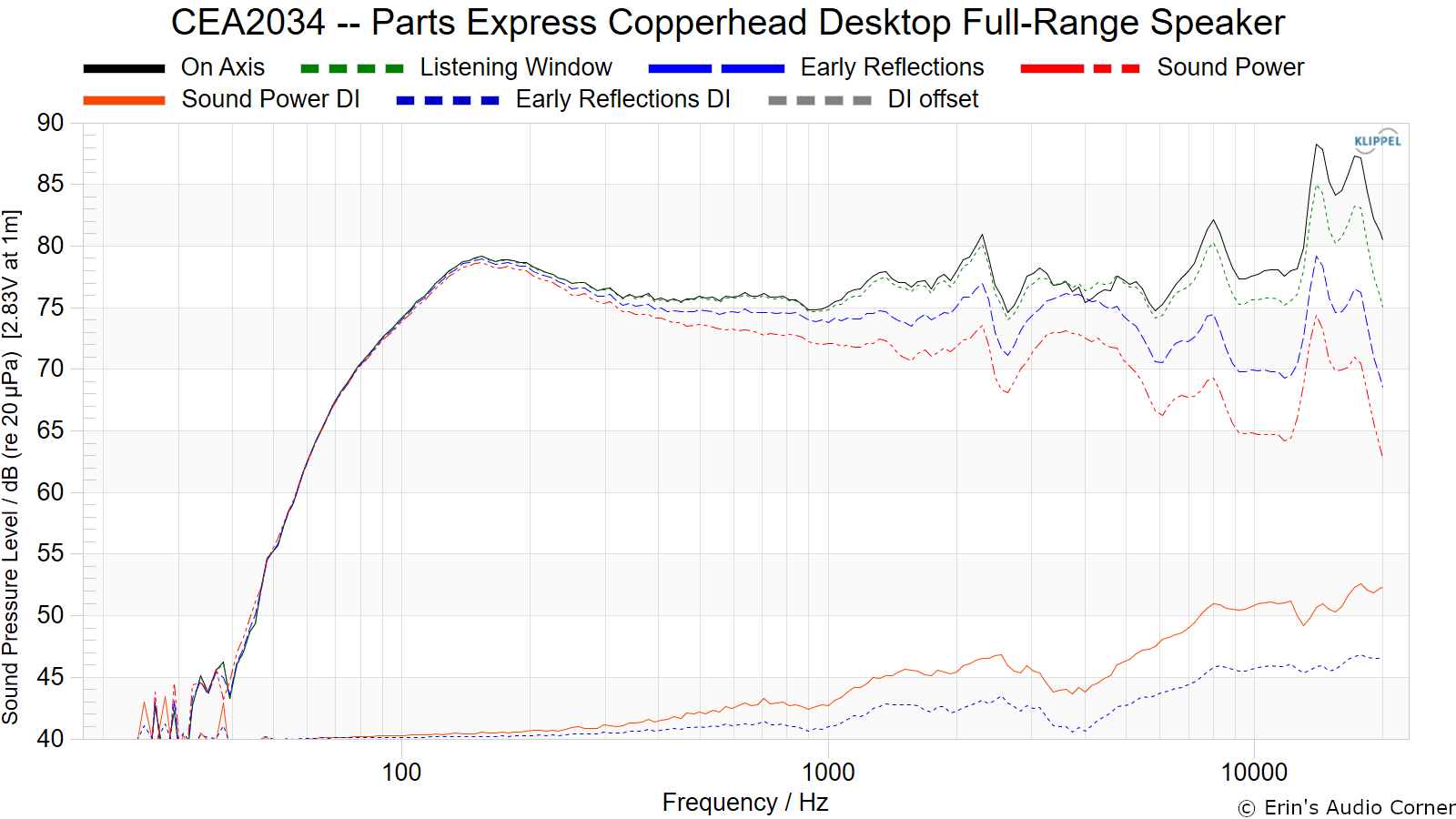
Early Reflections Breakout:
Floor bounce: average of 20º, 30º, 40º down
Ceiling bounce: average of 40º, 50º, 60º up
Front wall bounce: average of 0º, ± 10º, ± 20º, ± 30º horizontal
Side wall bounces: average of ± 40º, ± 50º, ± 60º, ± 70º, ± 80º horizontal
Rear wall bounces: average of 180º, ± 90º horizontal

Estimated In-Room Response:
In theory, with complete 360-degree anechoic data on a loudspeaker and sufficient acoustical and geometrical data on the listening room and its layout it would be possible to estimate with good precision what would be measured by an omnidirectional microphone located in the listening area of that room. By making some simplifying assumptions about the listening space, the data set described above permits a usefully accurate preview of how a given loudspeaker might perform in a typical domestic listening room. Obviously, there are no guarantees, because individual rooms can be acoustically aberrant. Sometimes rooms are excessively reflective (“live”) as happens in certain hot, humid climates, with certain styles of interior décor and in under-furnished rooms. Sometimes rooms are excessively “dead” as in other styles of décor and in some custom home theaters where acoustical treatment has been used excessively. This form of post processing is offered only as an estimate of what might happen in a domestic living space with carpet on the floor and a “normal” amount of seating, drapes and cabinetry.
For these limited circumstances it has been found that a usefully accurate Predicted In-Room (PIR) amplitude response, also known as a “room curve” is obtained by a weighted average consisting of 12 % listening window, 44 % early reflections and 44 % sound power. At very high frequencies errors can creep in because of excessive absorption, microphone directivity, and room geometry. These discrepancies are not considered to be of great importance.

Horizontal Frequency Response (0° to ±90°):

Vertical Frequency Response (0° to ±40°):

Horizontal Contour Plot (normalized):
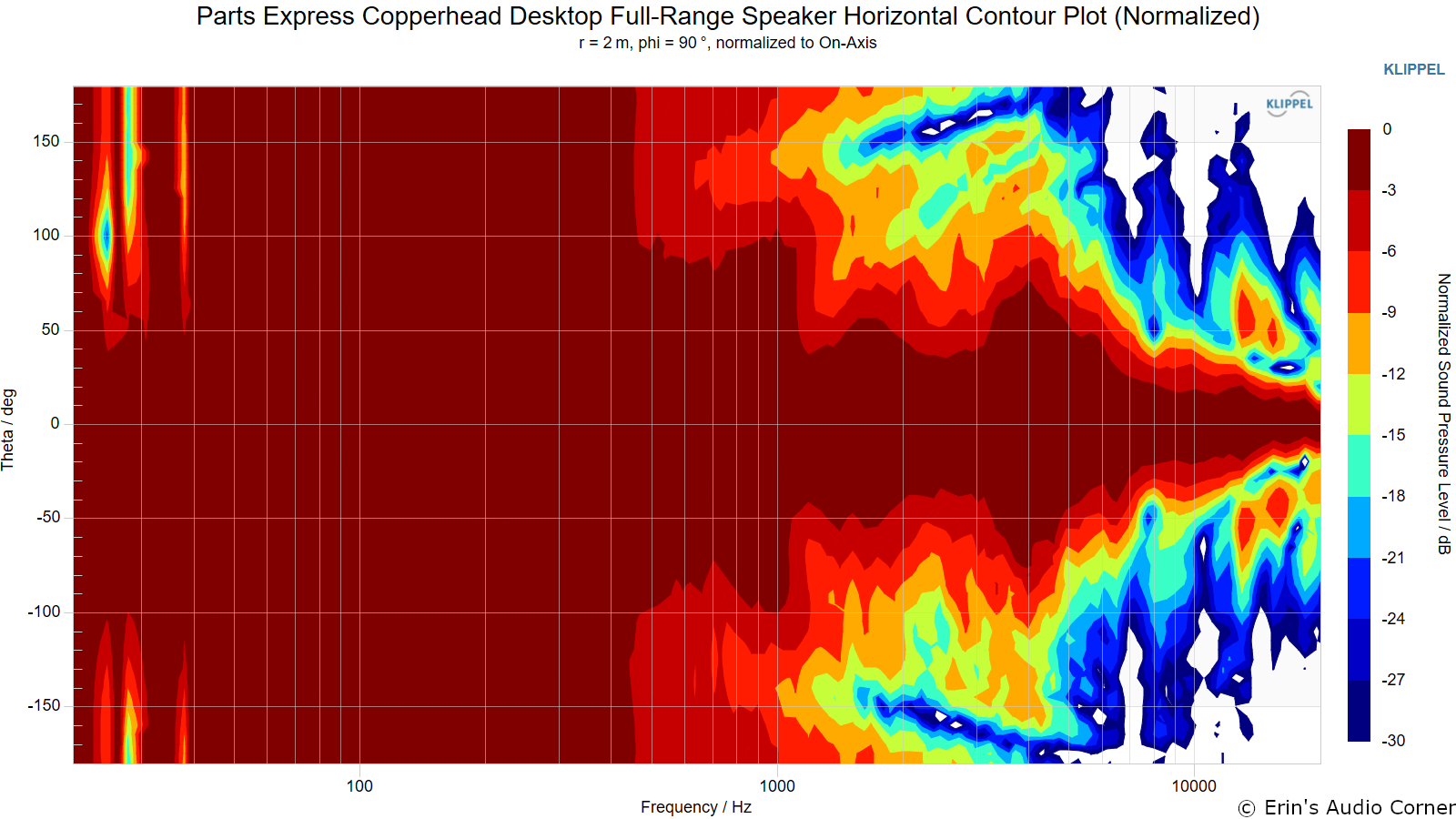
Vertical Contour Plot (normalized):

“Globe” Plots
Horizontal Polar (Globe) Plot:
This represents the sound field at 2 meters - above 200Hz - per the legend in the upper left.
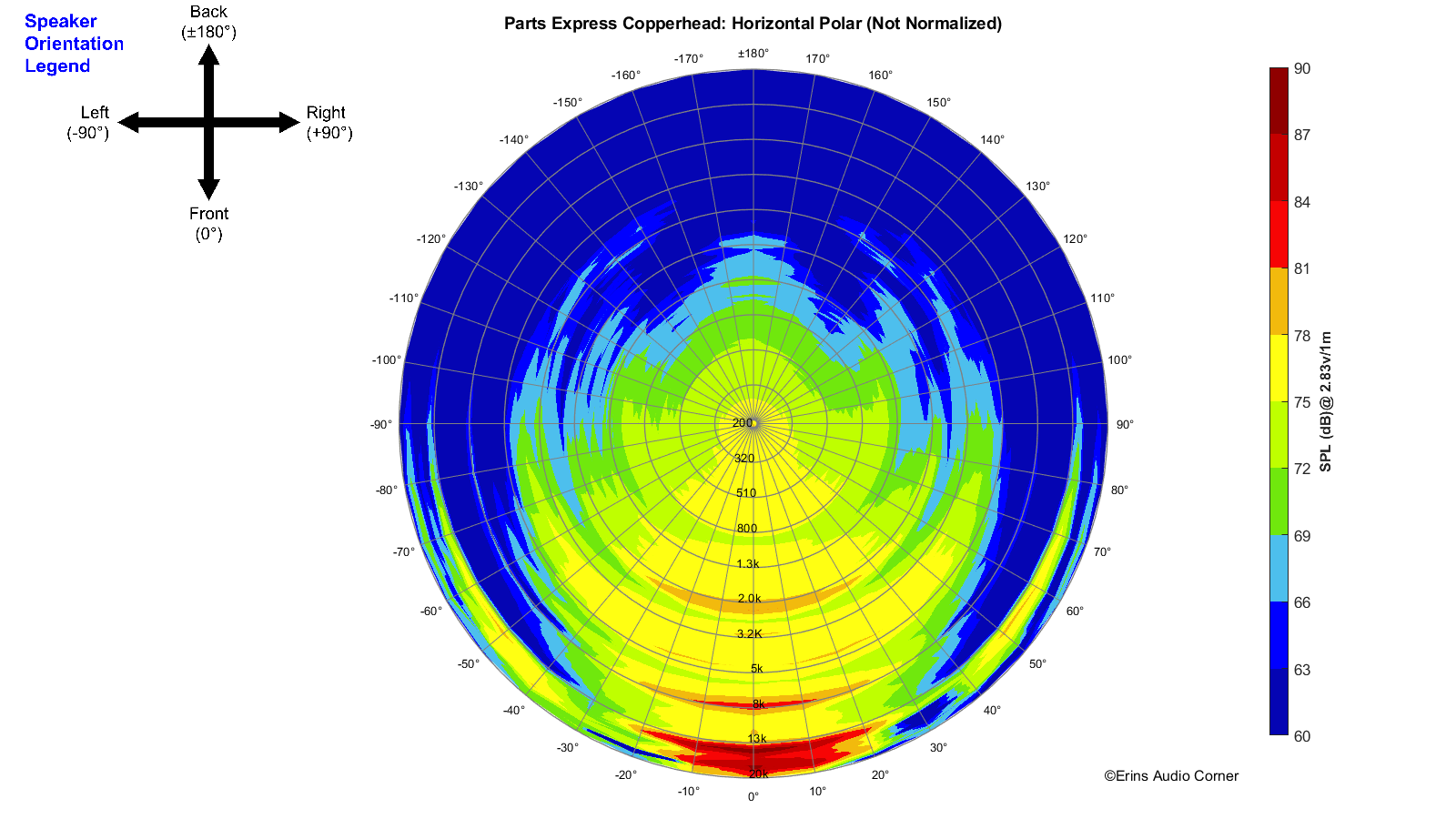
Vertical Polar (Globe) Plot:
This represents the sound field at 2 meters - above 200Hz - per the legend in the upper left.
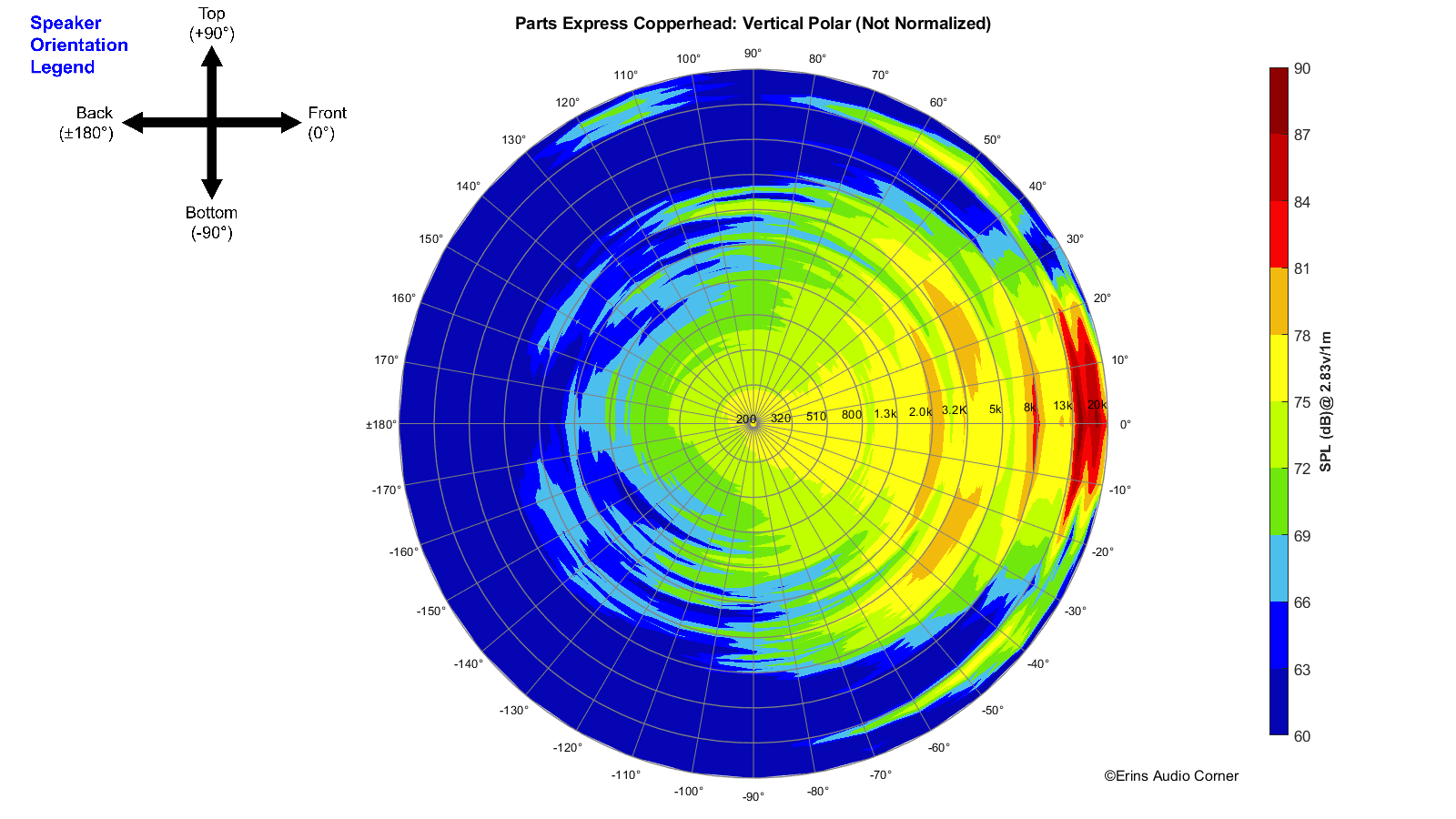
Additional Measurements
Response Linearity
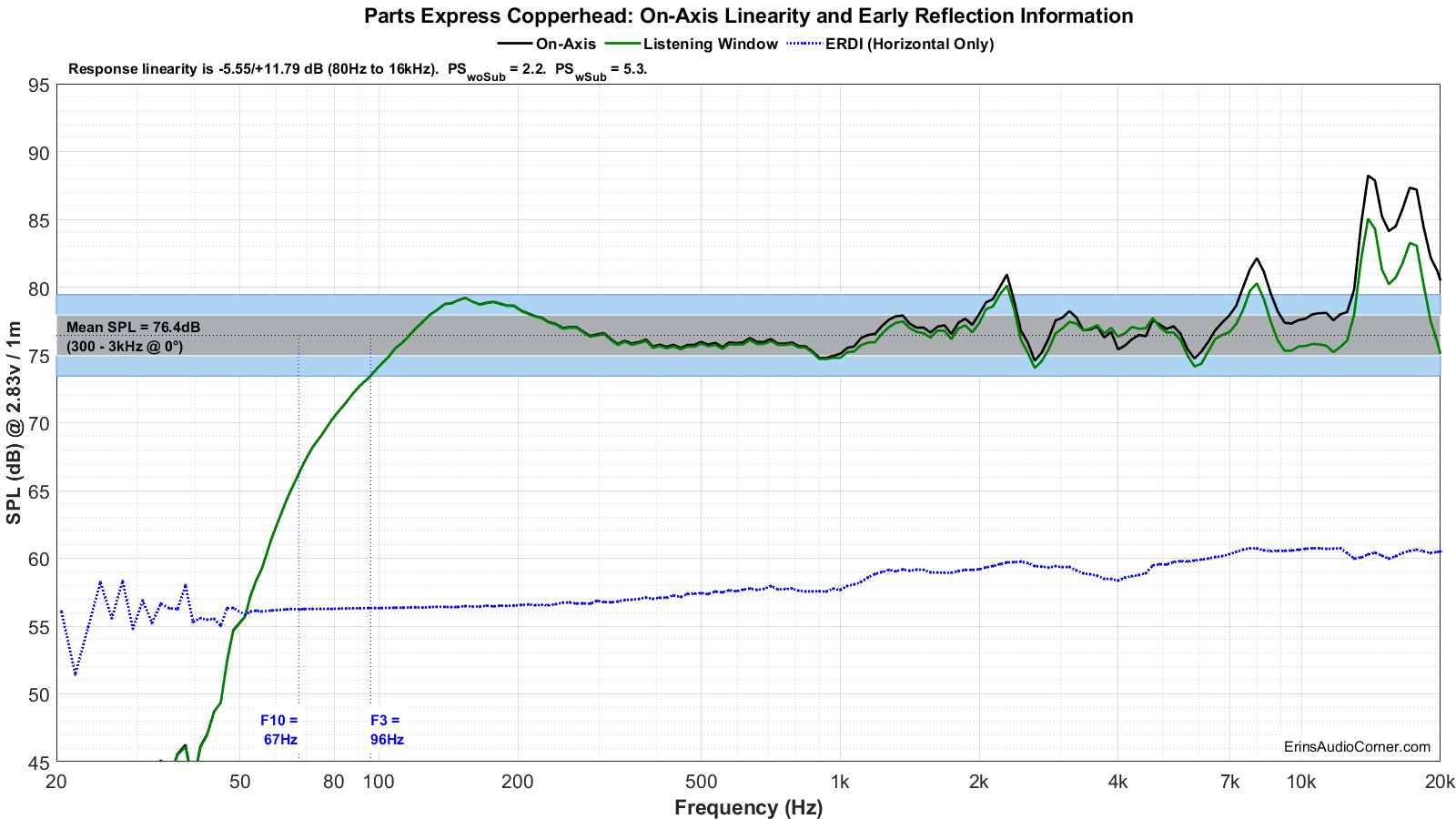
Impedance Magnitude and Phase

Step Response
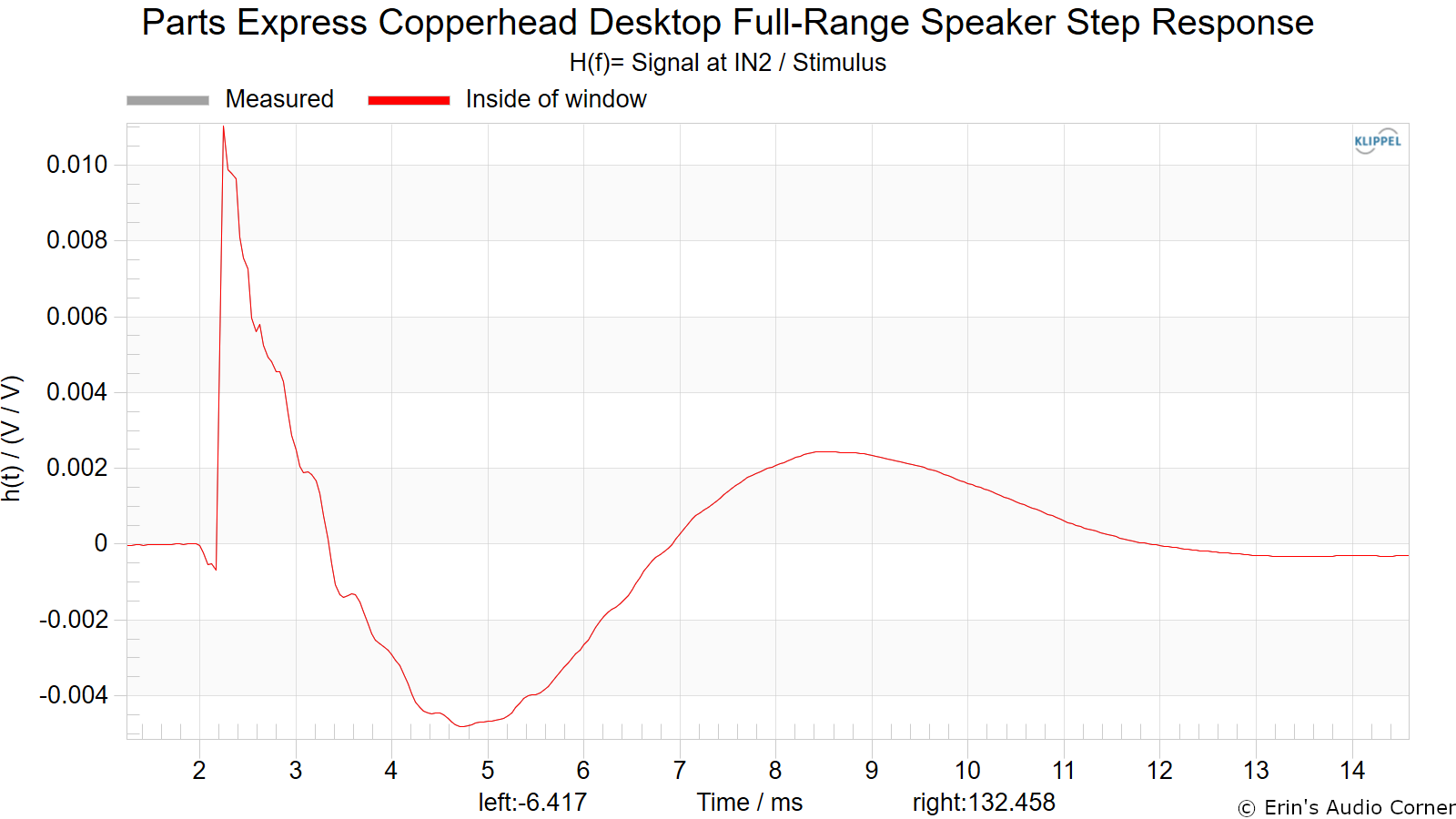
Group Delay
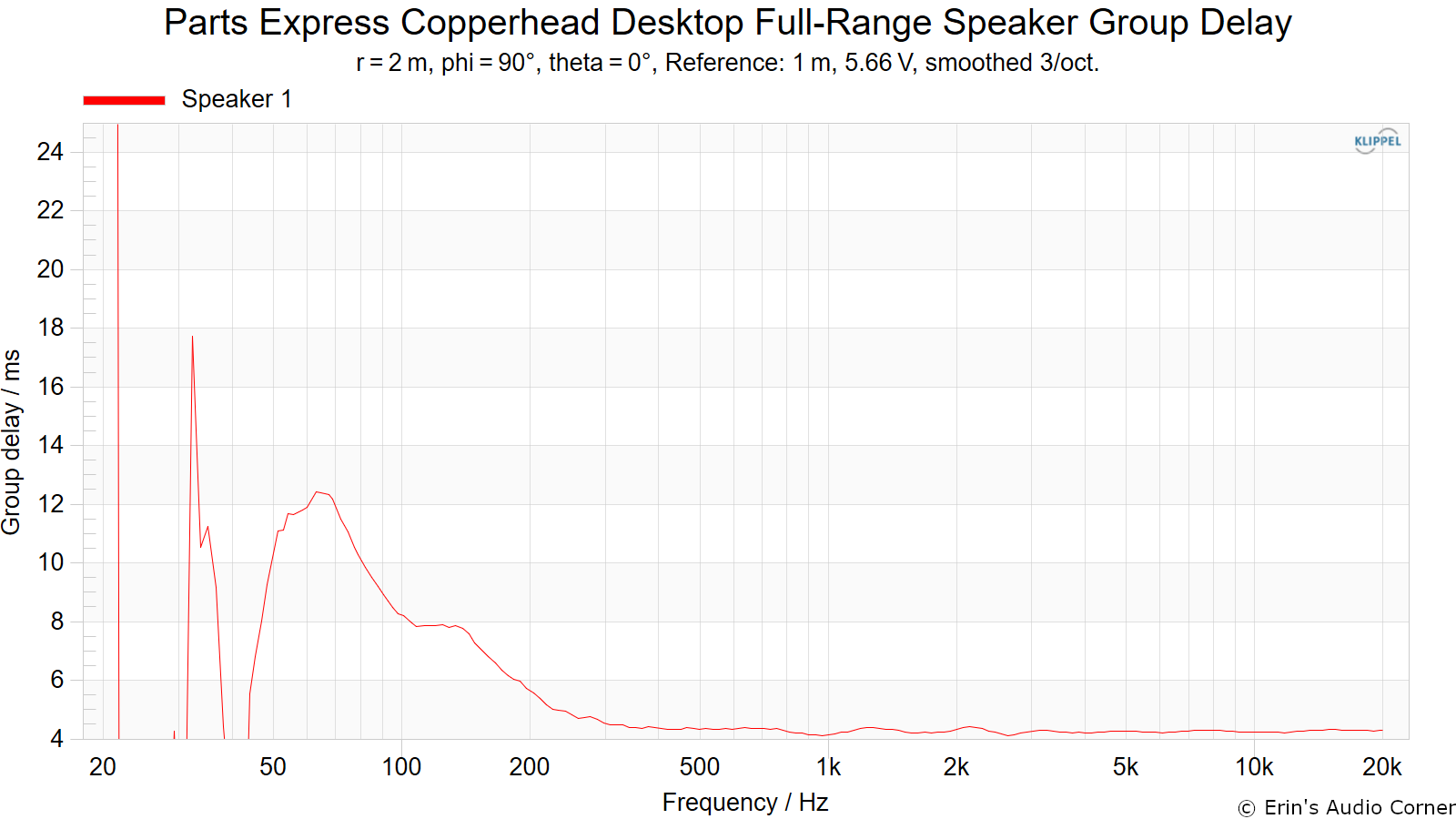
Harmonic Distortion
Harmonic Distortion at 86dB @ 1m:
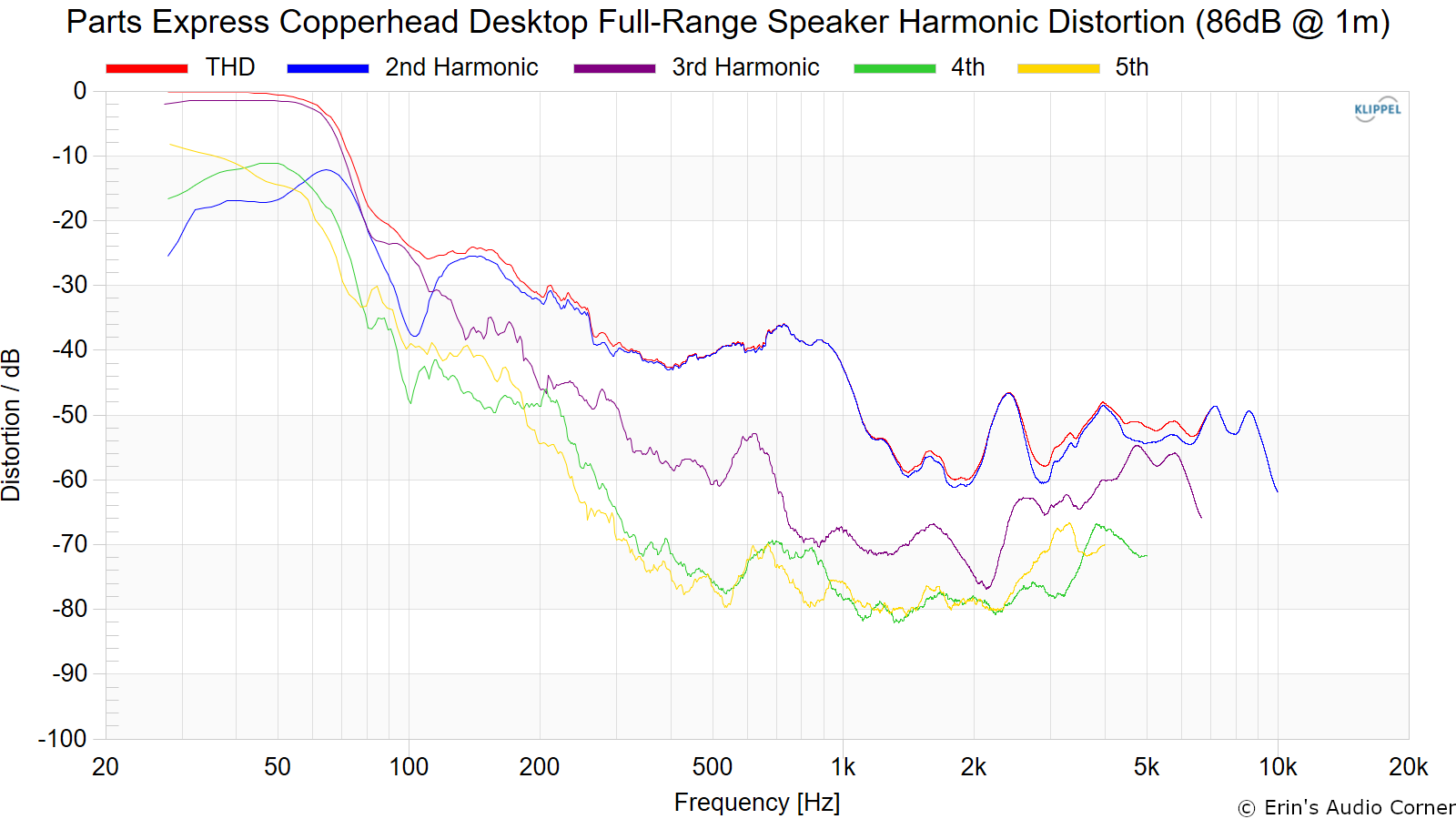
Harmonic Distortion at 96dB @ 1m:
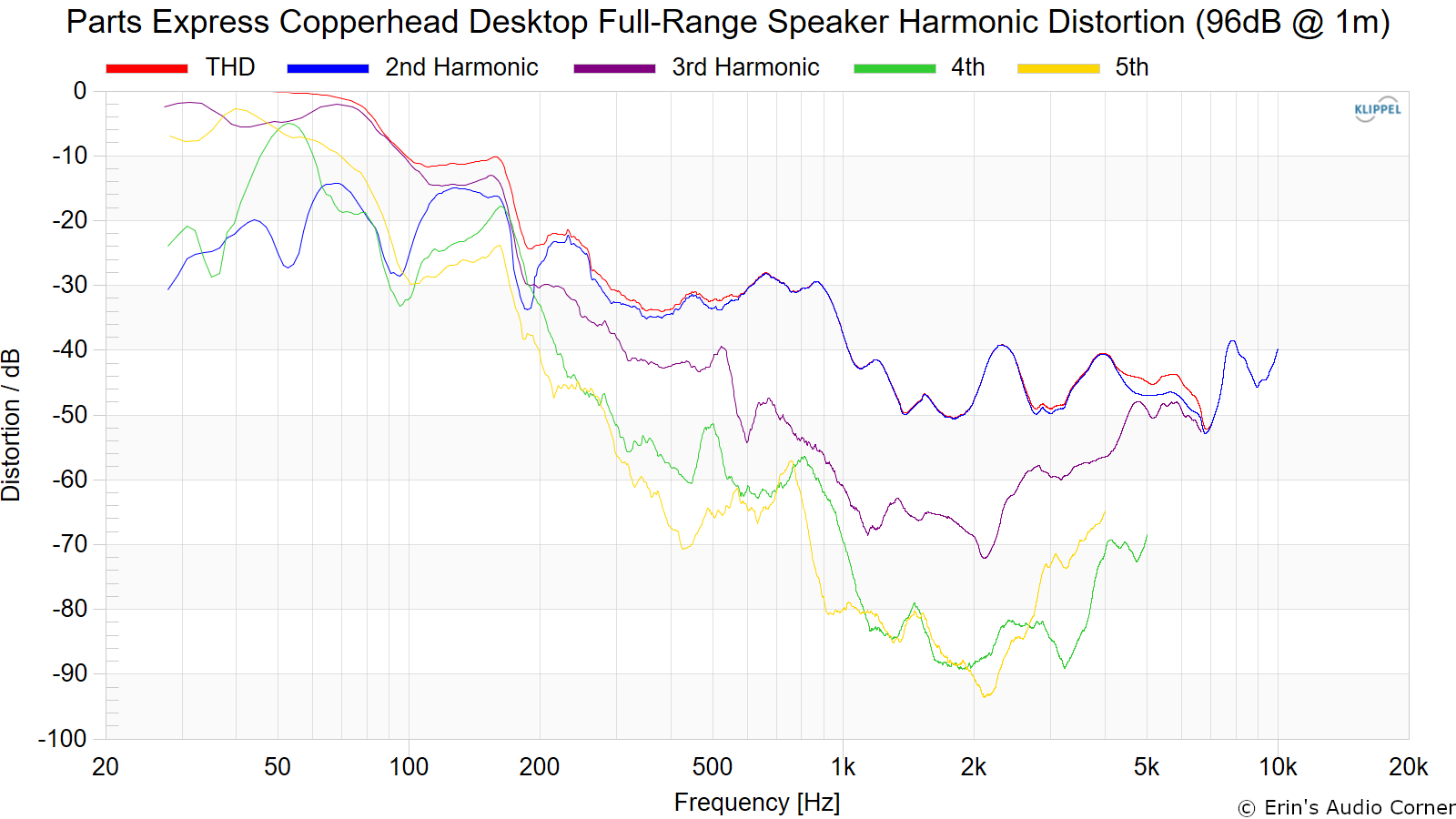
Dynamic Range (Instantaneous Compression Test)
The below graphic indicates just how much SPL is lost (compression) or gained (enhancement; usually due to distortion) when the speaker is played at higher output volumes instantly via a 2.7 second logarithmic sine sweep referenced to 76dB at 1 meter. The signals are played consecutively without any additional stimulus applied. Then normalized against the 76dB result.
The tests are conducted in this fashion:
- 76dB at 1 meter (baseline; black)
- 86dB at 1 meter (red)
- 96dB at 1 meter (blue)
- 102dB at 1 meter (purple)
The purpose of this test is to illustrate how much (if at all) the output changes as a speaker’s components temperature increases (i.e., voice coils, crossover components) instantaneously.

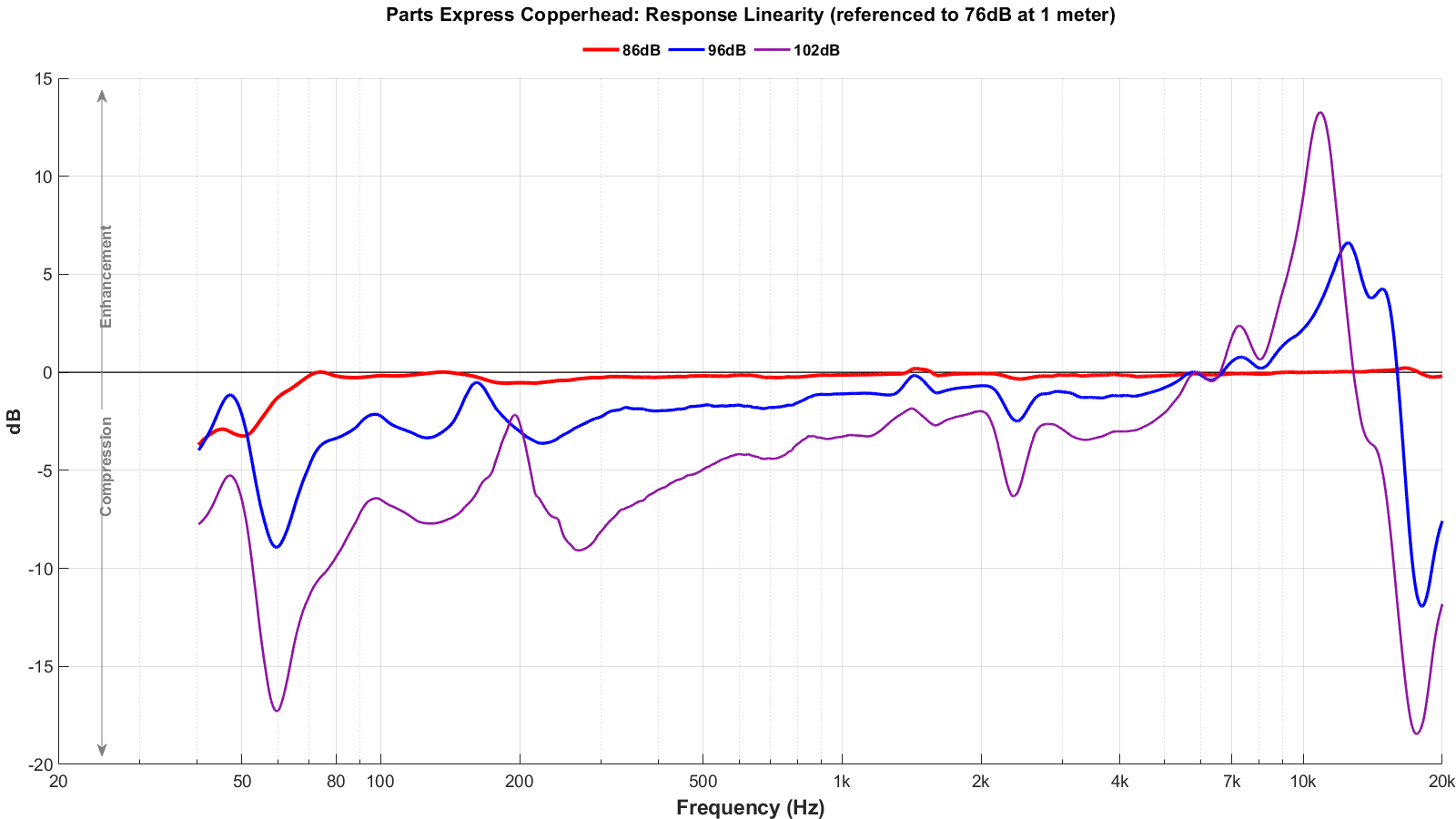
Multitone Distortion
The following tests are conducted at (4) approximate equivalent output volumes: 70/79/87/96dB @ 1 meter. The (4) voltages listed in the legend result in these SPL values.
The test was conducted in (3) manners:
- Full bandwidth (20Hz to 20kHz)
- 100Hz to 20kHz
- 200Hz to 20kHz
The reason for the additional two measurements is because it is unfair to expect a small speaker to extend low in frequency. Applying these three tests will provide a good idea of the limitations if you were to want to run the speaker full range vs using it with a HPF. However, note: the 2nd and 3rd test low frequency limits are a “brick wall” and don’t quite emulate a standard filter of 12 or 24dB/octave. But… it’s close enough.
For information on how to read the below data, watch this video:
- Full bandwidth (20Hz to 20kHz)
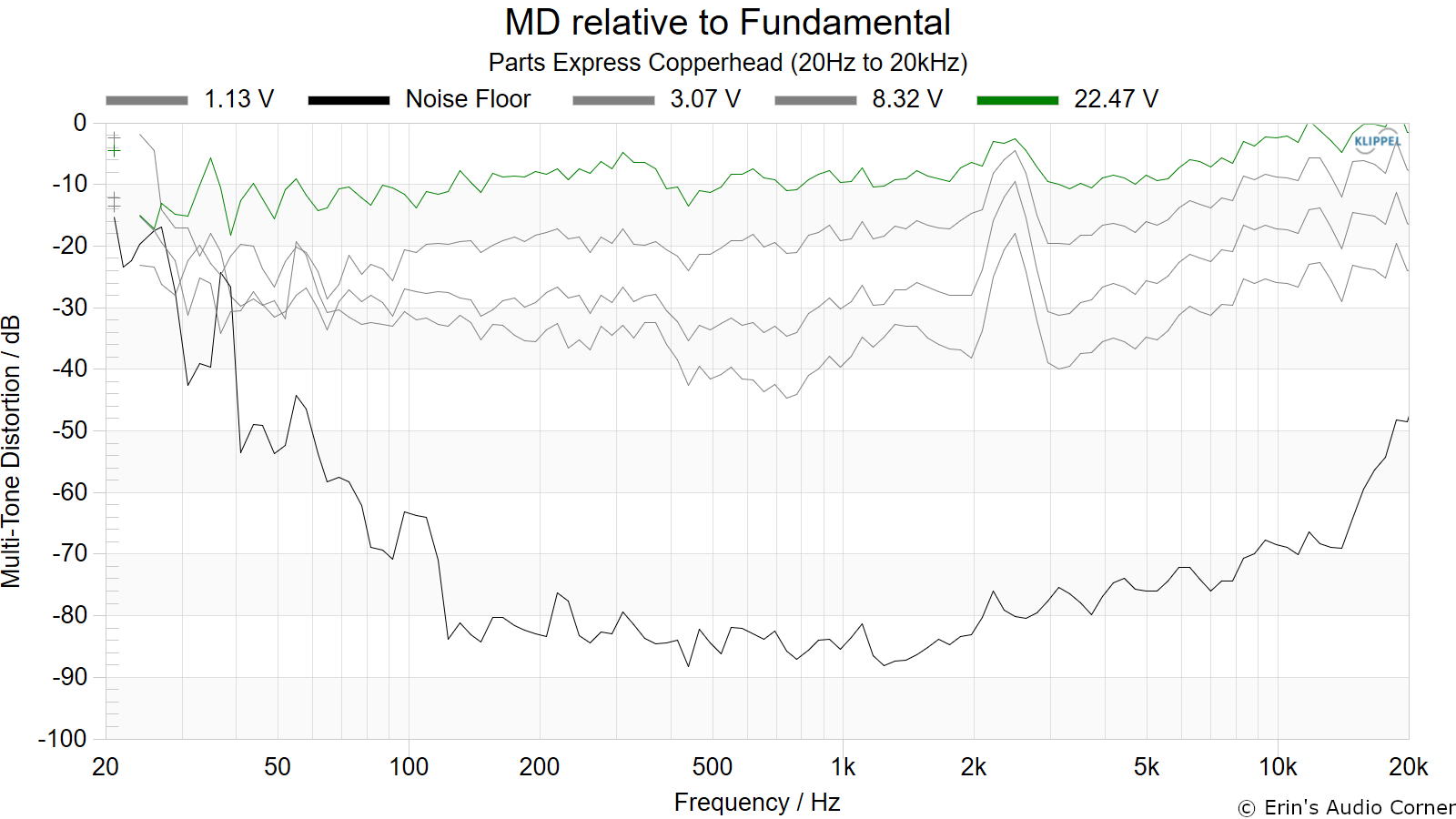
- 100Hz to 20kHz

- 200Hz to 20kHz

Direct Comparison (96dB @ 1m)
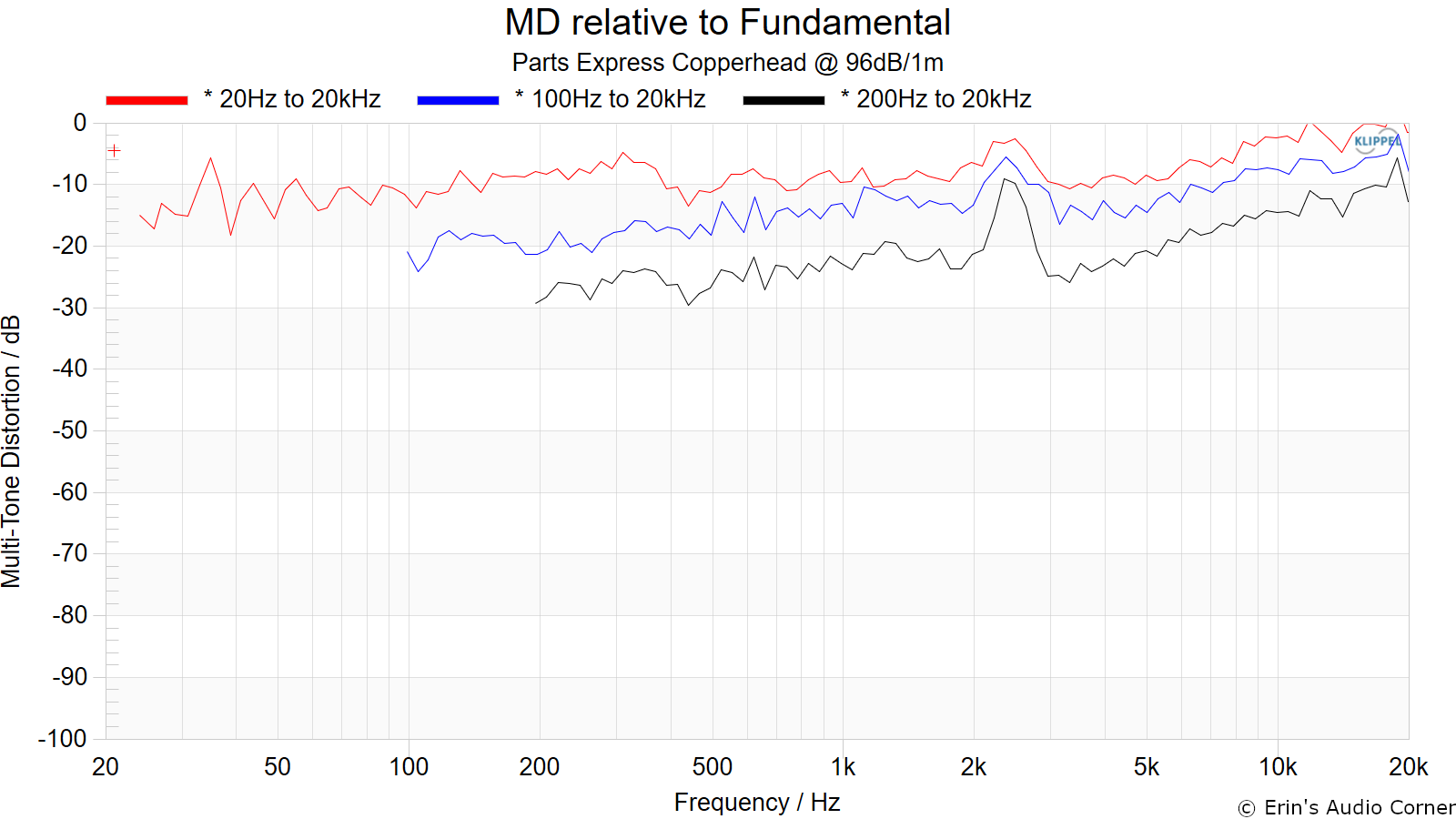
Crossover Components Impact
Per Parts-Express’ manual (link):
These speakers include notch filters to provide a smooth, fatigue free listening experience. The main filter includes three components wired in parallel with each other, with all three wired in series to the PS95 driver. The addition of the L2 inductor is optional in this design. This will help flatten the rising treble response and is recommended for near field or on-axis listening applications.
Below, I have provided an overlay of the impact these crossover components have so you can see for yourself the importance of implementing the baffle step compensation and the high-frequency attenuation. Though, the HF attenuation could definitely use more if you are sitting on axis.
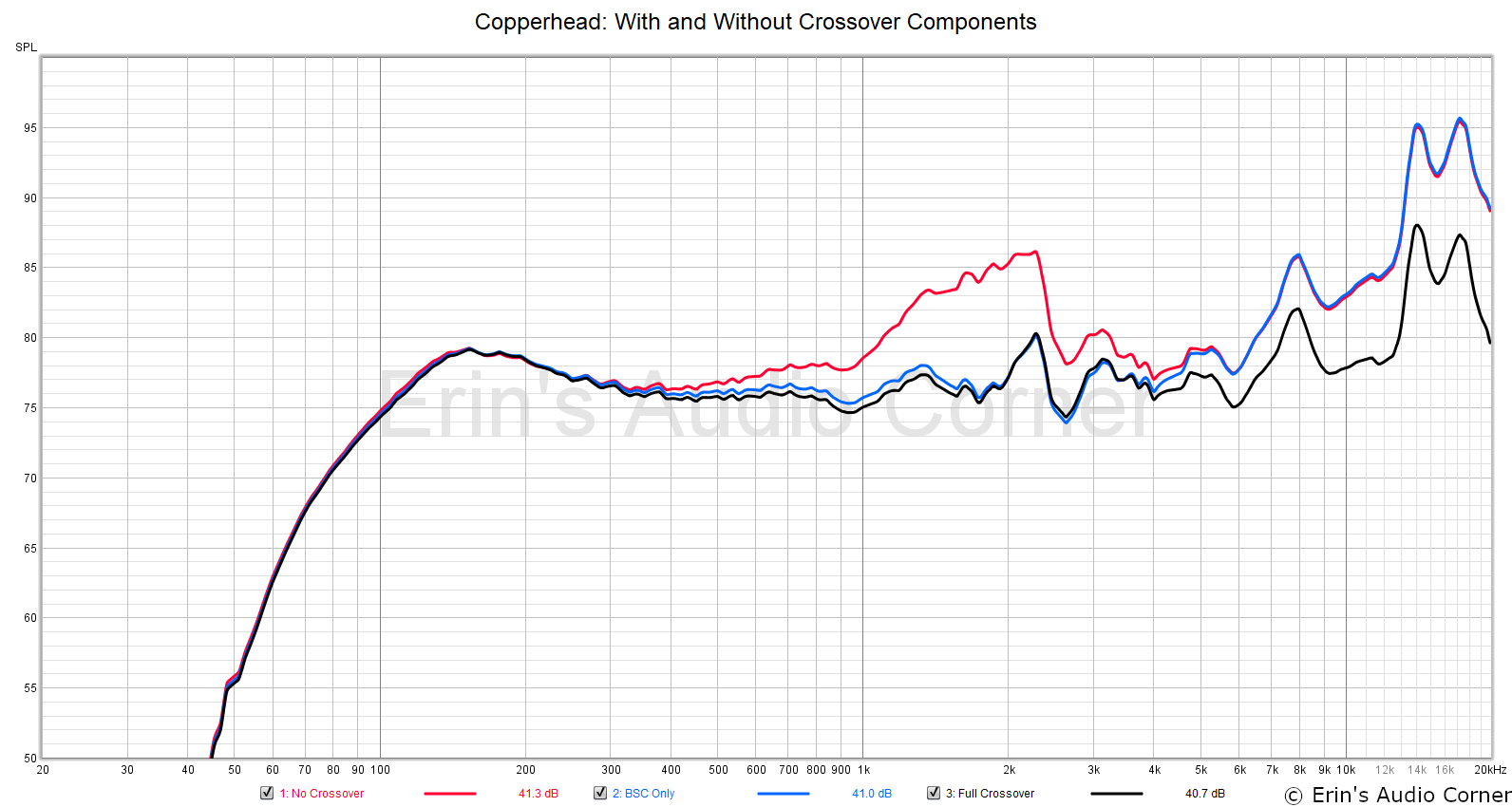
Comparison vs Simulation and Raw Data
Once my testing of the completed speaker was finished I then disconnected the crossover and measured the response of the individual drivers (while still attached to the cabinet). Using KLIPPEL’s Near Field Scanner “Export” module I then exported the magnitude+phase of each driver as a text file (360° vertical and horizontal in 10° increments). I imported those files to VituixCAD along with the impedance phase+magnitude and used the crossover schematic provided by Parts-Express to verify the performance and then to tinker a bit to see if I could improve the crossover and overall performance. You can see this matches nearly perfectly to the measured performance of the completed speaker.
While I am not providing suggestions for a modified crossover, I have a link to the raw data should anyone be interested in trying their own hand at simulating the crossover and possibly making tweaks. That data can be found here (dropbox link).

Parting / Random Thoughts
As stated in the Foreword, this written review is purposely a cliff’s notes version. For details about the performance (objectively and subjectively) please watch the YouTube video. But a couple quick notes based on my listening and what I see in the data:
- With a speaker of this size one must have to understand the inherent output limitations. So, while the distortion and compression data above paint a pretty terrible picture, keep in mind that this speaker wasn’t meant to play at levels more than probably 80dB at a few feet away. The product is, after all, literally named “desktop speaker”. With that said, however, I did run into audible distortion in the midrange while listening to a pair of these at about 1-2 meters away at about 85dB. I think this sets the stage quite well for the output limitations and matches the data provided above.
- The linearity of this speaker could definitely use some work. But, I performed this test on-axis. When using these as computer speakers and sitting at a typical distance of 1 to 2 feet, you’re likely to find yourself anywhere from 20° to 40° above the on-axis reference line. Therefore, it is reasonable to conclude that the treble wouldn’t be nearly as sharp. And we also see this in the vertical SPL data I’ve provided.
- Speaking of linearity, let’s consider that this is a single driver speaker. Regardless of it being called a “full-range” drive unit, it beams just like all speakers do. Woofers beam. Tweeters beam. Full-range speakers beam. It’s physics. But what makes a good full-range speaker is one that controls its resonances and maintains good directivity (by way of controlling its resonances) above its beaming frequency. If there is a breakup mode that peaks at one angle but dips at another then that’s not good directivity control. And that’s more often the case than not. Looking at the horizontal and vertical data for this speaker, I think it’s pretty fair to say that the drive unit in this speaker - the Dayton PS95-8 - performs admirably. The first off-axis issue we see in the horizontal data is at about 4kHz which is likely caused by diffraction, judging by the width of the baffle. Thanks to the fact that the driver itself is already beaming at this point, the diffraction is somewhat minimized. We see the on-axis dip relative to the off-axis response out to about 50° (and you can also see this in the normalized horizontal contour plot via the “flare” at this frequency). If this speaker were still omnidirectional then we would see the response off-axis out to 90° be higher in SPL than the on-axis response at this frequency. There are a couple areas where the off-axis response(s) intertwine (i.e., 8kHz, 12kHz, 16kHz) but all-in-all, it’s not too bad. And this indicates that the majority of the tonal balance of this speaker can be corrected via EQ.
If you’re a tinkerer, download the raw driver+enclosure data I’ve provided, import it into VituixCAD and try your hand at seeing if you can improve the performance. Let me know what you come up with by joining my Facebook group and sharing your results!
In short, this is a very limited-use speaker. But Parts-Express doesn’t try to market it as more than it is. And that’s important. Rather, Parts-Express is saying “here is a desktop, nearfield speaker and has a usable region of 80Hz to 20kHz”.
If you put these at ear level you’ll never forgive yourself; the high frequencies are way too hot at ear level. However, if you put these on a desk and sit above them and listen at low volumes then I think you’ll find yourself to be satisfied with the overall performance. The fact they should respond well to equalization throughout most of the bandwidth is helpful to adjust the timbre to taste depending on the positioning of them relative your ears. At $119 for the kit, I don’t think anyone should be disappointed in what they get and I don’t really have a problem recommending them as long as these caveats are understood.
Now … I gotta find a Patron who wants these …
Support the Cause
If you find this review helpful and want to help support the cause there are a few ways you can do so below. Your support helps me pay for new items to test, hardware, miscellaneous items needed for testing and costs of the site’s server space and bandwidth. Any help is very much appreciated.
Join my Patreon: Become a Patron!
Or using my product affiliate link below to buy this speaker or anything they sell that you want to try out. This will earn me a small commission at no additional cost to you. You can use these links anytime; now or in the future.
You can also join my Facebook and YouTube pages if you’d like to follow along with updates.